UPDATES
TEEN AGERSIranian students stand up to regime
More and more Iranian students, including schoolchildren, are joining the protest wave. Iranian security forces are resorting to increasingly brutal measures to quell the demonstrations.
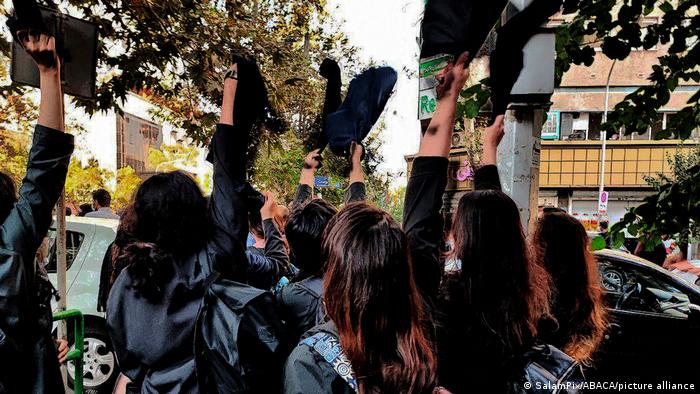
Iranian students remove their headscarves during a protest in Tehran
Every day, new pictures and videos of Iranian protesters from all parts of the country are shared online, despite moves to restrict internet access. Students have also joined the protests and many have been arrested and jailed.
On Tuesday, videos were posted of demonstrations at Ferdowsi University of Mashhad, Iran's second largest university, calling for the release of their fellow students, especially those from the elite Sharif University of Technology in the capital Tehran. Students there were arrested on Sunday evening after staging a peaceful campus protest.
Police and security forces surrounded the campus and fired on students with shotguns. Numerous videos posted online show students being hunted down. Several lecturers were beaten with batons. It is not yet known whether any individuals were killed or injured in the crackdown. Iranian media, meanwhile, report that at least 37 students were arrested.
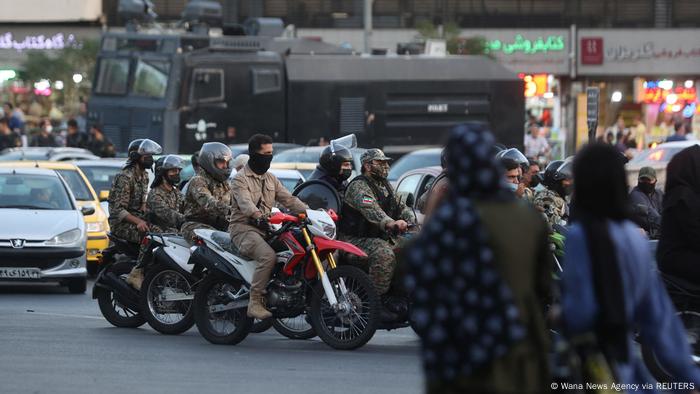
Riot police have been used to supress protests in Tehran and across the country
"This is supposed to intimidate other students," 50-year-old Maryam from Tehran, whose real name has been withheld for security reasons, told DW. She has two children, both of whom are studying. "Every time they leave the apartment, my heart starts racing and I feel nauseous until they return," she said.
"We are not doing well; we are sad and angry.The death of Mahsa Amini was a shock for us, she could have been my daughter."
Deadly violence
This protest wave was initially sparked by the death of 22-year-old Mahsa Amini, who died after being arrested by Iranian morality police for allegedly breaching the country's strict rules on head coverings. The exact cause of Amini's death remains disputed.
Iranian security forces have attempted to suppress rallies with brute force. Until Tuesday, at least 154 people have been killed in connection with the protests, according to NGO Iran Human Rights (IHR), many of them by gunshots.
In late September, human rights organization Amnesty International reported that Iranian authorities are making deliberate use of lethal force, and said they "have mobilized their well-honed machinery of repression to ruthlessly crackdown on nationwide protests."
"This show of solidarity among students for [other Iranian] protesters could pose a challenge for the state leadership," says Iran expert Hamidreza Azizi of Berlin's German Institute for International and Security Affairs (SWP), who was an assistant professor at Tehran's Shahid Beheshti University from 2016 to 2020.
Iran, a country of 84 million, has over 200 universities and academies. Traditionally, students have played a key role in Iranian protest movements, for instance "during the 1979 revolution, and also later, for example during the protest waves of 1998 und 2009," said Azizi.
"Students supply intellectual backing and have the potential to mobilize different sectors of society, because they, too, come from different parts of society."
Iran's leadership is well-ware of the students' potential for protest, through so far, there is no organized student movement. Following nationwide protests in 2009, all independent student organizations were shut down and leading members arrested.
"On top of that, new rules concerning the localized assignment of university places were pushed through," said Aziz. "The idea is to keep many young people studying close to home to keep them under their family's supervision, instead of living in student accommodation in constant contact with others."
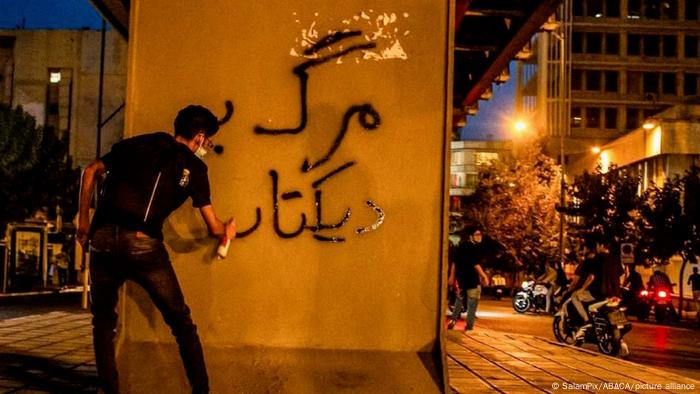
An Iranian protester writes "Death to the dictator!" on a wall in Tehran
"Student residences, especially those in Tehran, are among the first places to be monitored; in 1998 and 2009,security forces stormed student residences and randomly arrested residents," said Aziz. Last Sunday, he added, halls of residence were raided at Sharif University. "Students may not be organized, but they cannot be underestimated, just like school protests."
School protests
In Iran, boys and girls are taught separately from the very first day right up until graduation. Even so, Iranian schools impose strict dress codes on girls. Countless videos have circulated online showing schoolgirls burning headscarves and shouting "death to the dictator." Boys schools, too, have been gripped by strikes and protests in solidarity with Iranian girls. "Unfortunately they have not been coordinated," Iranian journalist Moloud Hajizadeh told DW.
Hajizadeh has been arrested numerous times for covering the suppression of Iranian protest movements. Most recently, in January 2021, she was sentenced to one year in jail. Yet just before starting her jail sentence, Hajizadeh fled Iran. She now lives in Norway.
"These protests are occurring in isolation from each other and do not last very long," said the journalist.
"Students have always been at the forefront of important protest movements in Iran; [now] they will have to leave their walled-off campuses, where can be easily encircled, and join others in the streets, taking a leading role even."
Only then, she said, "will the protest movement take on a new dimension, with enough power to bring about big changes."
This article was translated from German.
DW RECOMMENDS
Iran releases singer arrested over protest anthem
Shervin Hajipour has been released on bail and is awaiting trail. He was detained by police shortly after his song in support of feminist protests across the country went viral.
Thousands of Iranians have taken to the streets in protest against the government, and have been venting their anger online. Dissidents claim that some of their posts on Instagram were deleted.
Date 06.10.2022
Author Shabnam von Hein
Related Subjects Iran
Keywords Iran, students, protest, school, Mahsa Amini
Permalink https://p.dw.com/p/4Ho4j
RELATED CONTENT
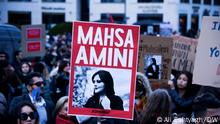
Iran: Deaths mount as Mahsa Amini protests continue 30.09.2022
Iranians have defied crackdowns and showed up for protests in cities across the country, posing a serious challenge to the establishment. A human rights group has said 83 people have died over the course of protests.
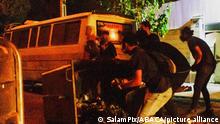
Iran: Protests spread to universities and schools 04.10.2022
Iran's president has echoed comments by the supreme leader, who blamed the unrest on the US and Israel. The protests began after the death of 22-year-old Mahsa Amini following her arrest for allegedly violating the Islamic Republic's strict dress code.
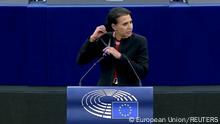
EU shows solidarity with Iranian protesters 05.10.2022
Anti-government protests in Iran are not abating. The unrest was triggered by the death of Mahsa Amini, who died in custody of the country's morality police. Her death has also drawn international condemnation and solidarity rallies.
Author Shabnam von Hein
Related Subjects Iran
Keywords Iran, students, protest, school, Mahsa Amini
Permalink https://p.dw.com/p/4Ho4j
Related Subjects Iran
Keywords Iran, students, protest, school, Mahsa Amini
Permalink https://p.dw.com/p/4Ho4j
Many of the recently arrested protesters have been teenagers, according to a senior IRGC official.
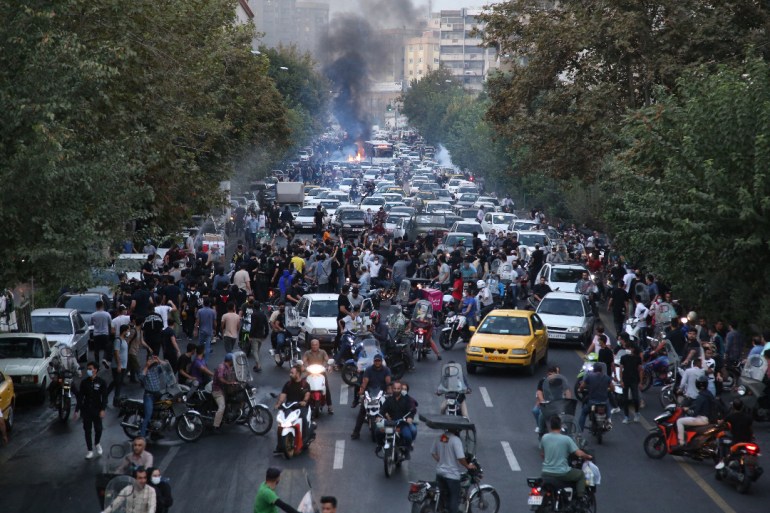
Iranian demonstrators took to the streets of the capital Tehran during a protest for Mahsa Amini, days after she died in police custody [AFP]
By Maziar Motamedi
Published On 5 Oct 2022
Tehran, Iran – Another round of counter-demonstrations have been organised in support of the Iranian state as protests that formed after the death of 22-year-old Mahsa Amini in police custody on September 16 approach the end of their third week.
Pro-government demonstrations in northern Tehran began in the early afternoon on Wednesday and are expected to last several hours. Like the two previous rounds, they were announced via state media and mass text messages, and were expected to condemn “recent riots and the crimes of seditionists”.
Wednesday marked the 19th day since the start of the protests, during which dozens have been killed and many arrested. The authorities have not released an official tally.
Ali Salehi, the capital’s attorney general, announced Tuesday that 400 people arrested in “riots” in Tehran have been released so far after committing never to repeat their acts.
A senior lawmaker briefed by intelligence authorities said the same day that an unknown number of “leaders of the riots” will remain imprisoned.
With the school year having started, videos of school children and teenagers taking their hijabs off and chanting slogans have been widely shared on social media.
Ali Fadavi, the second-highest commander in the Islamic Revolutionary Guard Corps (IRGC), said on Wednesday that the “average age of the many of the recently arrested is 15 years” and that many of them had fallen “victim” to a narrative pushed on social media and foreign-based outlets.
Meanwhile, the death of a teenage girl who joined the protests in Tehran has been widely shared on social media. Nika Shakarami went missing for 10 days just before she turned 17 before her family finally found her body in a morgue in Tehran. She had reportedly suffered severe head trauma.
An investigation into her death has been launched, but authorities have rejected allegations that she may have been beaten by security forces.
State-affiliated media reported on Wednesday that Shakarami’s body was found in the courtyard of a home after falling from the roof of a neighbouring house, and eight people who were in the vicinity at the time have been arrested.
University students have also featured prominently in the protests so far on campuses across the country. Riot police earlier this week surrounded the prestigious Sharif University of Technology in Tehran and arrested an unknown number. Officials have since said that “most” of the students have been released.
Online activity surrounding the protests has also continued, with Amini’s name prominently used on Twitter.

Judiciary chief Gholam-Hossein Mohseni-Ejei said on Tuesday that the time it took from Amini’s arrest by Iran’s so-called “morality police” in Tehran on September 13 until her collapse from an apparent stroke in a police “re-education” centre was less than an hour.
His remarks came in support of assertions by Iranian authorities that Amini was not mistreated or beaten, and suffered from pre-existing conditions, something her family have rejected. An investigation into her death is expected to yield results within days.
‘Foreign intervention’
As the protests have continued amid lingering internet restrictions, top Iranian authorities have repeatedly condemned what they have called a “foreign presence” behind the unrest.
Supreme Leader Ayatollah Ali Khamenei on Monday said “riots and insecurity” in the country had been caused by the United States and Israel.
Officials have also condemned statements and sanctions by the US in support of the protests. The European Union has also signalled that it is considering human rights sanctions against Tehran.
“We are unhappy with positions and interventions by some European officials on recent events, and if the EU wishes to make a hasty and uncalculated move showing double standards, it must await the effective and reciprocating act by the Islamic Republic,” Iranian foreign minister Hossein Amirabdollahian warned his Italian counterpart in a phone call on Wednesday.
Earlier on Wednesday, the Iranian foreign ministry had summoned the United Kingdom ambassador, Simon Shercliff, for a second time in 10 days to “strongly condemn interventionist statements” by British officials.
SOURCE: AL JAZEERA
By Maziar Motamedi
Published On 5 Oct 2022
Tehran, Iran – Another round of counter-demonstrations have been organised in support of the Iranian state as protests that formed after the death of 22-year-old Mahsa Amini in police custody on September 16 approach the end of their third week.
Pro-government demonstrations in northern Tehran began in the early afternoon on Wednesday and are expected to last several hours. Like the two previous rounds, they were announced via state media and mass text messages, and were expected to condemn “recent riots and the crimes of seditionists”.
Wednesday marked the 19th day since the start of the protests, during which dozens have been killed and many arrested. The authorities have not released an official tally.
Ali Salehi, the capital’s attorney general, announced Tuesday that 400 people arrested in “riots” in Tehran have been released so far after committing never to repeat their acts.
A senior lawmaker briefed by intelligence authorities said the same day that an unknown number of “leaders of the riots” will remain imprisoned.
With the school year having started, videos of school children and teenagers taking their hijabs off and chanting slogans have been widely shared on social media.
Ali Fadavi, the second-highest commander in the Islamic Revolutionary Guard Corps (IRGC), said on Wednesday that the “average age of the many of the recently arrested is 15 years” and that many of them had fallen “victim” to a narrative pushed on social media and foreign-based outlets.
Meanwhile, the death of a teenage girl who joined the protests in Tehran has been widely shared on social media. Nika Shakarami went missing for 10 days just before she turned 17 before her family finally found her body in a morgue in Tehran. She had reportedly suffered severe head trauma.
An investigation into her death has been launched, but authorities have rejected allegations that she may have been beaten by security forces.
State-affiliated media reported on Wednesday that Shakarami’s body was found in the courtyard of a home after falling from the roof of a neighbouring house, and eight people who were in the vicinity at the time have been arrested.
University students have also featured prominently in the protests so far on campuses across the country. Riot police earlier this week surrounded the prestigious Sharif University of Technology in Tehran and arrested an unknown number. Officials have since said that “most” of the students have been released.
Online activity surrounding the protests has also continued, with Amini’s name prominently used on Twitter.

Judiciary chief Gholam-Hossein Mohseni-Ejei said on Tuesday that the time it took from Amini’s arrest by Iran’s so-called “morality police” in Tehran on September 13 until her collapse from an apparent stroke in a police “re-education” centre was less than an hour.
His remarks came in support of assertions by Iranian authorities that Amini was not mistreated or beaten, and suffered from pre-existing conditions, something her family have rejected. An investigation into her death is expected to yield results within days.
‘Foreign intervention’
As the protests have continued amid lingering internet restrictions, top Iranian authorities have repeatedly condemned what they have called a “foreign presence” behind the unrest.
Supreme Leader Ayatollah Ali Khamenei on Monday said “riots and insecurity” in the country had been caused by the United States and Israel.
Officials have also condemned statements and sanctions by the US in support of the protests. The European Union has also signalled that it is considering human rights sanctions against Tehran.
“We are unhappy with positions and interventions by some European officials on recent events, and if the EU wishes to make a hasty and uncalculated move showing double standards, it must await the effective and reciprocating act by the Islamic Republic,” Iranian foreign minister Hossein Amirabdollahian warned his Italian counterpart in a phone call on Wednesday.
Earlier on Wednesday, the Iranian foreign ministry had summoned the United Kingdom ambassador, Simon Shercliff, for a second time in 10 days to “strongly condemn interventionist statements” by British officials.
SOURCE: AL JAZEERA
No comments:
Post a Comment